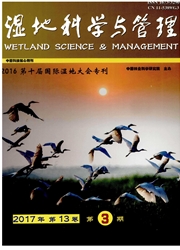

 中文摘要:
中文摘要:
选取了杭州湾滨海湿地芦苇Phragmites australis湿地、互花米草Spartina alterniflora湿地、海三棱藨草Scirpus mariqueter湿地以及光滩湿地,研究了土壤脲酶、蔗糖酶、β-葡萄糖苷酶、磷酸酶活性及土壤溶解性碳(DOC)、土壤微生物量碳(MBC)在0~20cm土层的分布特征及其内在相关性,探讨酶活性与土壤有机碳及其组分的关系。结果表明,表层(0~5cm)土壤的酶活性和有机碳含量最高,随着土壤深度的增加,土壤酶活性和土壤有机碳含量呈下降趋势。相关分析表明,土壤碱性磷酸酶、蔗糖酶与总有机碳呈显著正相关,土壤脲酶与土壤溶解性有机碳呈显著正相关,蔗糖酶、β-葡萄糖苷酶以及碱性磷酸酶活性与土壤微生物量碳或溶解性碳呈负相关,表明不同的土壤酶对湿地土壤有机碳库组成的贡献不同。
 英文摘要:
英文摘要:
To understand the influence of vertical dynamics of soil enzyme activities on the active carbon pool in Hangzhou Bay wetland,the vertical distribution in 0-20cm depth of soil urease,invertase,β-glucosidase,phosphatase and active arganic carbon indicators(microbial biomass carbon,MBC;dissolved organic carbon,DOC) were measured and the relationship between the enzyme activities and the soil organic carbon and its components were analyzed.The results indicated that enzyme activities and organic carbon indicators of topsoil layer were the greatest.Soil enzyme activities and the amount of active organic carbon(MBC,DOC) decreased from the surface down to 20 cm.Correlation analysis revealed that the soil enzyme activities were significantly positive correlated to soil organic carbon content.And urease activity with DOC had the greatest correlation coefficient,however,the activities of invertase,β-glucosidase,and phosphatase had the greatest negative correlation with DOC and MBC,the activities of phosphatase and invertase had the greatest correlation with TOC.Different soil enzymes have different contributions to the soil organic carbon pool.
 同期刊论文项目
同期刊论文项目
 同项目期刊论文
同项目期刊论文
 期刊信息
期刊信息
